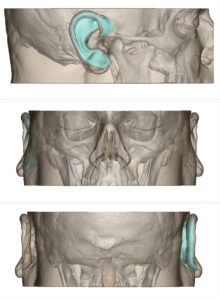Reconstruction of lost or congenitally malformed ears requires the combination of a solid framework and soft tissue coverage of it. Two techniques for making a framework for the ear have been developed over the years. By history and still commonly used today is to make the framework by harvesting and assembling rib cartilage grafts. While technically challenging to successfully create the intricate topography of the ear, its autologous composition offers a hardy framework that is very durable over time and has a very low risk of any complications long-term. It also can be placed under the existing skin over the implantation site if it is of good quality.
The other ear reconstruction technique is to use a premade synthetic framework. This creates the best shape of the ear, shortens the operative time and avoids a rib graft harvest scar and its associated discomfort. But it can not just be placed under the natural thin skin of the ear. It requires a vascularized tissue cover, using a pedicled temporalis flap turned down from above to cover the synthetic framework, which is then covered by a skin graft. This requires two donor sites from the temporal scalp (fascial flap) as well as the thigh. (skin graft) Adequate soft tissue cover is of paramount importance to avoid the risks of implant exposure and infection both short and long-term.
The traditional ear synthetic framework is that of porous polyethylene or Medpor. It comes in a variety of implant shapes and parts to be assembled during surgery based on the size and shape of the opposite normal ear. While creating acceptable results, this assembly approach never creates a prefect match to the opposite ear.


Dr. Barry Eppley
Indianapolis, Indiana


